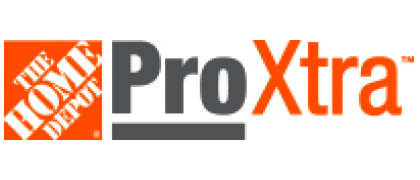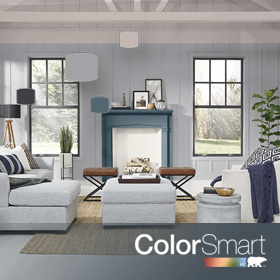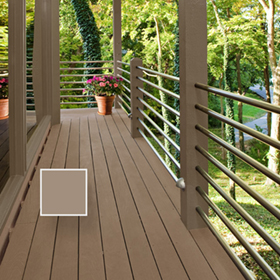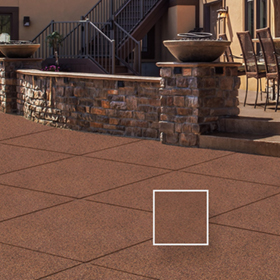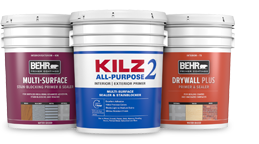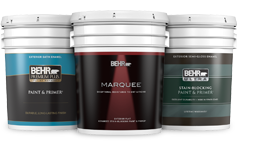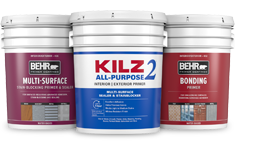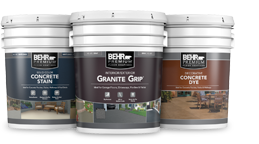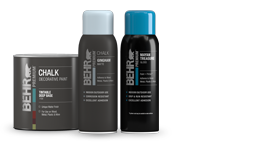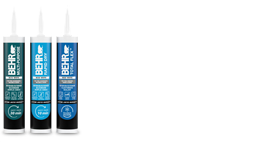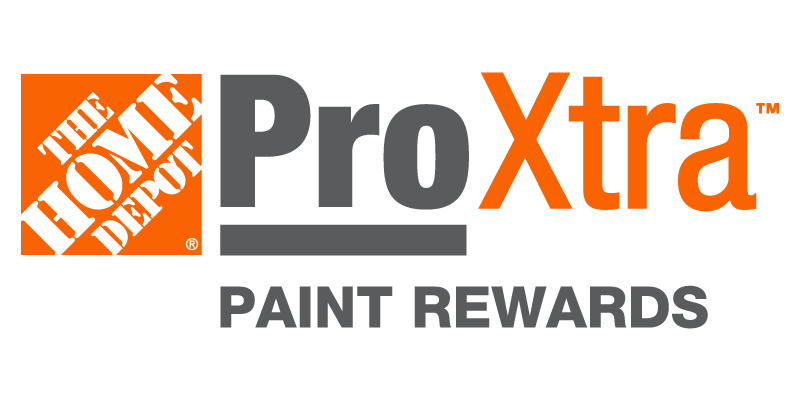TDS, SDS & Sustainability Certifications
BEHR® and KILZ® Paints & Primers’ Technical Data Sheets (TDS) detail product specifications, application methods, and performance characteristics. Safety Data Sheets (SDS) provide essential information for safe handling, including hazards and first-aid procedures. Environmental Product Declarations (EPD) and Health Product Declarations (HPD) highlight environmental and health impacts, while GREENGUARD certification ensures compliance with strict chemical emissions limits for healthier indoor air.
FILTER
- Interior Products (0)
- Exterior Products (4)
- Tools And Supplies (0)
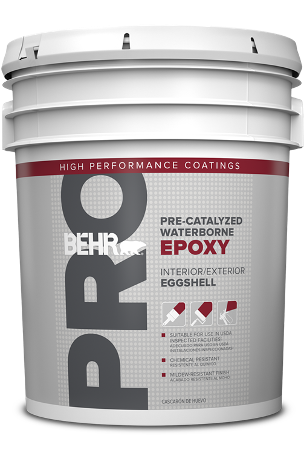
BEHR PRO® PRE-CATALYZED WATERBORNE EPOXY EGGSHELL NO. HP140

BEHR PRO® PRE-CATALYZED WATERBORNE EPOXY SEMI-GLOSS NO. HP150

BEHR PREMIUM® Interior/Exterior DIRECT-TO-METAL SEMI-GLOSS PAINT NO. 3200

BEHR PREMIUM® Interior/Exterior DIRECT-TO-METAL EGGSHELL PAINT NO. 7200

BEHR PREMIUM® URETHANE ALKYD SATIN ENAMEL NO. 7900

BEHR PREMIUM® URETHANE ALKYD SEMI-GLOSS ENAMEL NO. 3900

BEHR PREMIUM® OIL-BASE SEMI-GLOSS ENAMEL NO. 3800

BEHR PREMIUM® OIL-BASE SATIN ENAMEL NO. 7800

BEHR® MASONRY, STUCCO & BRICK FLAT PAINT NO. 270

BEHR® MASONRY, STUCCO & BRICK SATIN PAINT NO. 280

BEHR PRO® WATERBORNE ACRYLIC DRYFALL FLAT NO. HP210

BEHR PREMIUM DRYPLUS® BASEMENT & MASONRY WATERPROOFER NO. 875

BEHR PREMIUM™ CHALK DECORATIVE PAINT NO. 7100

BEHR PRO® Block Filler Primer
No. PR050

BEHR PRO® High Build Interior Primer
No. PR040

BEHR PRO® Concrete & Masonry Primer No. PR060

BEHR® Kitchen, Bath & Trim Stain-Blocking Primer & Sealer No. 75

BEHR® Drywall Plus Primer & Sealer No. 73

BEHR® Multi-Surface Interior/Exterior Stain-Blocking Primer & Sealer No. 436

BEHR PREMIUM® Concrete & Masonry Bonding Primer No. 880

BEHR Interior/Exterior Metal Primer No. 435

BEHR® Interior/Exterior Bonding Primer No. 432

BEHR® Acrylic-Alkyd Enamel Undercoater No. 437

KILZ® ORIGINAL No. 1000

KILZ® ORIGINAL Aerosol No. 1024

KILZ® ORIGINAL LOW ODOR No. 1004

KILZ® ORIGINAL Low Odor Aerosol No. 1044

KILZ® ORIGINAL Interior/Exterior Primer No. 1009

KILZ® ORIGINAL Interior/Exterior Primer Aerosol No. 1008

KILZ 2® ALL-PURPOSE Interior/Exterior Primer, Sealer & Blocker No. 2000

KILZ 2® GRAY Interior/Exterior Primer No. 2200

KILZ® 3 PREMIUM Interior/Exterior Heavy-Duty Primer, Sealer & Stain Blocker No. 1300

KILZ® PVA Drywall Interior Primer & Sealer No. PX010

KILZ® KLEAR™ Interior/Exterior Primer No. L2201

KILZ RESTORATION Interior Primer® No. L2002

KILZ Upshot® Aerosol No. 10007

KILZ® MOLD & MILDEW Interior/Exterior Primer No. L2046

KILZ® MOLD & MILDEW No. L204644

BEHR PREMIUM® Oil-Based Pre Stain Wood Conditioner No. B1080

BEHR Premium® Penetrating Oil-Based Wood Stain No. B3400

BEHR PREMIUM® Fast Drying Oil-Based Polyurethane No. B7100

BEHR PREMIUM® Oil-Based Spar Urethane No. B7200

BEHR PREMIUM® Water-Based Pre Stain Wood Conditioner No. B2080

BEHR® Fast Drying
Water-Based Wood Stain No. B4500
 Dark Walnut No. B4502
Dark Walnut No. B4502
 Jacobean No. B4504
Jacobean No. B4504
 Ebony No. B4506
Ebony No. B4506
 Red Mahogany No. B4508
Red Mahogany No. B4508
 Golden Oak No. B4510
Golden Oak No. B4510
 Classic Gray No. B4512
Classic Gray No. B4512
 Special Walnut No. B4514
Special Walnut No. B4514
 Early American No. B4516
Early American No. B4516
 Espresso No. B4518
Espresso No. B4518
 English Chestnut No. B4520
English Chestnut No. B4520
 Golden Pecan No. B4522
Golden Pecan No. B4522
 Natural No. B4524
Natural No. B4524
 Provincial No. B4526
Provincial No. B4526
 Red Oak No. B4528
Red Oak No. B4528
 Gunstock No. B4530
Gunstock No. B4530
 Cherry No. B4532
Cherry No. B4532
 White Wash Pickling No. B4580
White Wash Pickling No. B4580


BEHR PREMIUM® Water-Based Stain & Poly in One No. B6260
 Satin Espresso No. B6212
Satin Espresso No. B6212
 Satin Honey No. B6230
Satin Honey No. B6230
 Satin Pecan No. B6252
Satin Pecan No. B6252
 Satin Bombay Mahogany No. B6254
Satin Bombay Mahogany No. B6254
 Satin Classic Oak No. B6256
Satin Classic Oak No. B6256
 Satin Mission Oak No. B6258
Satin Mission Oak No. B6258
 Satin Antique Walnut No. B6260
Satin Antique Walnut No. B6260
 Satin American Chestnut No. B6262
Satin American Chestnut No. B6262
 Gloss Clear Tint Base No. B6301
Gloss Clear Tint Base No. B6301
 Gloss Espresso No. B6312
Gloss Espresso No. B6312
 Gloss Honey No. B6330
Gloss Honey No. B6330
 Gloss Pecan No. B6352
Gloss Pecan No. B6352
 Gloss Bombay Mahogany No. B6354
Gloss Bombay Mahogany No. B6354
 Gloss Classic Oak No. B6356
Gloss Classic Oak No. B6356
 Gloss Mission Oak No. B6358
Gloss Mission Oak No. B6358
 Gloss Antique Walnut No. B6360
Gloss Antique Walnut No. B6360
 Gloss American Chestnut No. B6362
Gloss American Chestnut No. B6362


BEHR PREMIUM® Wood Effects No. B84600

BEHR PREMIUM ® Water-Based Spar Urethane No. B8200

BEHR PREMIUM® Fast Drying
Water-Based Polyurethane No. B8100

BEHR PRO® Fast Drying
Water-Based Polyurethane No. B8500

BEHR PREMIUM® Interior/Exterior Concrete & Garage Self-Priming 1-Part Epoxy No. 900

BEHR PREMIUM® Granite Grip® No. 650

BEHR PREMIUM® Porch & Patio Floor Paint - Low-Lustre Enamel No. 6050

BEHR PREMIUM® Porch & Patio Floor Paint - Gloss Enamel No. 6705

BEHR PREMIUM® Solid Color Concrete Stain No. 800

BEHR PREMIUM® Semi-Transparent Decorative Concrete Stain No. 855

BEHR PREMIUM® Anti-Slip Floor Finish Additive No. 970

BEHR PREMIUM® Color Enhancing Sealer No. 982

BEHR PREMIUM® Porch & Patio Anti-Slip Floor Paint - Textured Low-Lustre Enamel No. 6250

BEHR PREMIUM™ Textured Spray Paint No. B061544

BEHR PREMIUM™ Metallic Spray Paint No. B060144
 Metallic Oil Rubbed Bronze Satin No. B060244
Metallic Oil Rubbed Bronze Satin No. B060244
 Metallic Soft Iron Satin No. B060544
Metallic Soft Iron Satin No. B060544
 Metallic Vintage Gold Gloss No. B060644
Metallic Vintage Gold Gloss No. B060644
 Metallic Nickel Satin No. B060744
Metallic Nickel Satin No. B060744
 Metallic Titanium Gloss No. B060844
Metallic Titanium Gloss No. B060844
 Metallic Antique Copper Gloss No. B062044
Metallic Antique Copper Gloss No. B062044
 Metallic Dark Steel Gloss No. B061844
Metallic Dark Steel Gloss No. B061844
 Metallic Champagne Gold Matte No. B061744
Metallic Champagne Gold Matte No. B061744
 Metallic Burnished Amber Matte No. B062244
Metallic Burnished Amber Matte No. B062244
 Metallic Red Gloss B063044
Metallic Red Gloss B063044


BEHR PREMIUM™ Hammered Spray Paint No. B060944

BEHR PREMIUM™ Chalk Decorative Spray Paint No. 70244

BEHR PREMIUM™ Wax Decorative Finish No.7140

BEHR PREMIUM™ Spray Paint No. B0001
 Baronial Brown Gloss B000744
Baronial Brown Gloss B000744
 Beyond Navy Flat B006144
Beyond Navy Flat B006144
 Black Evergreen Satin B008444
Black Evergreen Satin B008444
 Black Gloss B000144
Black Gloss B000144
 Black Matte B002144
Black Matte B002144
 Black Satin B006844
Black Satin B006844
 Blazing Bonfire Gloss No. B000644
Blazing Bonfire Gloss No. B000644
 Blue Bandana Gloss
Blue Bandana Gloss
 Breezeway Satin B007044
Breezeway Satin B007044
 Citrus Orange Gloss
Citrus Orange Gloss
 Congo Gloss No. B001244
Congo Gloss No. B001244
 Dark Truffle Flat B006344
Dark Truffle Flat B006344
 Desert Coral Flat B007944
Desert Coral Flat B007944
 Deep Espresso Satin B007244
Deep Espresso Satin B007244
 Flirt Alert Gloss B000944
Flirt Alert Gloss B000944
 HIdden Sea Glass Gloss B000444
HIdden Sea Glass Gloss B000444
 Hopeful Dream Satin B007744
Hopeful Dream Satin B007744
 Inked Gloss B000544
Inked Gloss B000544
 Iron Mountain Satin B002944
Iron Mountain Satin B002944
 Luck of the Irish Gloss B001144
Luck of the Irish Gloss B001144
 Lunar Surface Flat B002244
Lunar Surface Flat B002244
 Lunar Surface Gloss B000344
Lunar Surface Gloss B000344
 Matcha Gloss B008544
Matcha Gloss B008544
 Mayan Treasure Gloss B001544
Mayan Treasure Gloss B001544
 New Terra Cotta Flat B009244
New Terra Cotta Flat B009244
 No More Drama Gloss B000844
No More Drama Gloss B000844
 Ocean Abyss Gloss B007644
Ocean Abyss Gloss B007644
 Orion Gray Gloss B000244
Orion Gray Gloss B000244
 Roasted Corn Gloss B005744
Roasted Corn Gloss B005744
 Sugary Pink Gloss
Sugary Pink Gloss
 Summer Sun Flat B007844
Summer Sun Flat B007844
 Toasty Gray Gloss B007144
Toasty Gray Gloss B007144
 Tree Top Green Gloss
Tree Top Green Gloss
 Tropics Gloss B001444
Tropics Gloss B001444
 Unmellow Yellow Gloss B001044
Unmellow Yellow Gloss B001044
 White Gloss B001944
White Gloss B001944
 White Matte B002044
White Matte B002044
 White Satin B006944
White Satin B006944
 Wild Manzanita Gloss B003744
Wild Manzanita Gloss B003744


BEHR PREMIUM™ Sand Spray Paint B063544

BEHR PREMIUM™ High Shine Spray Paint B062644

BEHR PREMIUM® CONCRETE SPRAY PAINT B064644

BEHR PREMIUM® SUEDE SPRAY PAINT B064244

ETX® SingleShot™ Wall Texture 3013

ETX® SingleShot™ Plus Wall & Ceiling Texture 3030

BEHR PREMIUM® Color Changing Multi-Purpose Spackling

BEHR PRO® Acrylic Texture Coating No. PR710

BEHR PREMIUM® Exterior High Build Coating No. 4700

BEHR PREMIUM® Elastomeric Masonry, Stucco & Brick Paint No. 68

BEHR® Barn & Fence Paint No. 25

BEHR® Multi-Surface Roof Paint No. 65

BEHR PREMIUM ADVANCED DECKOVER® No. 5000

BEHR PREMIUM ADVANCED DECKOVER® Textured No. 5005

BEHR PREMIUM® Solid Color Waterproofing Stain & Sealer No. 5011

BEHR PREMIUM® Semi-Transparent Waterproofing Stain & Sealer No. 5077

BEHR PREMIUM® Transparent Waterproofing Wood Finish No. 500

BEHR DECKplus® Solid Color Waterproofing Wood Stain No. 211

BEHR DECKplus® Semi-Transparent Waterproofing Wood Stain No. 3077

BEHR DECKplus® Transparent Waterproofing Wood Finish No. 400

BEHR® Solid Color House & Fence Wood Stain No. 11

BEHR PREMIUM® Transparent Log Home Gloss Finish No. 15

BEHR® Oil-Latex Redwood Stain No. 9

BEHR PREMIUM® Semi-Transparent Waterproofing Stain and Sealer Penetrating Oil - Cedar/ Naturaltone/ Chocolate/ Redwood

BEHR PREMIUM® Transparent Waterproofing Wood Finish Penetrating Oil - Clear

BEHR PREMIUM® Wet-Look Sealer No. 985

BEHR PREMIUM® Low-Lustre Sealer No. 986

BEHR PREMIUM® Protector & Waterproofer No. 980

BEHR PREMIUM® Concrete Crack Filler No. 972

BEHR® Multi-Purpose Siliconized Acrylic Caulk No. BC10

BEHR® Rapid Dry Siliconized Acrylic Caulk No. BC20

BEHR® Window & Trim Advanced Hybrid Sealant No. BP40

BEHR PREMIUM® ALL-IN-ONE WOOD CLEANER NO. 63

BEHR PREMIUM® Wood Stain & Finish Stripper No. 64

BEHR DYNASTY® Interior Matte Paint 1650

BEHR DYNASTY® Interior Eggshell Enamel 2650

BEHR DYNASTY® Interior Semi-Gloss Enamel No. 3650

BEHR DYNASTY® Interior Satin Enamel No. 7650

BEHR® COPPER FORCE™ Interior Eggshell Enamel No. 2190

BEHR® COPPER FORCE™ Interior Semi-Gloss Enamel No. 3190

BEHR MARQUEE® Interior Matte Paint No. 1450

BEHR MARQUEE® Interior Eggshell Enamel No. 2450

BEHR MARQUEE® Interior Satin Enamel No. 7450

BEHR MARQUEE® Interior Semi-Gloss Enamel No. 3450

BEHR MARQUEE® Stain-Blocking Paint and Primer Ceiling Paint No. 1458

BEHR ULTRA® Interior Extra Durable Flat Paint No. 1720

BEHR ULTRA® Interior Eggshell Enamel No. 2750

BEHR ULTRA® Interior Satin Enamel No. 7750

BEHR ULTRA® Interior Semi-Gloss Enamel No. 3750

BEHR ULTRA® Stain-Blocking Ceiling Paint No. 5558

PREMIUM PLUS® Interior Flat Paint No. 1050

PREMIUM PLUS® Interior Eggshell Enamel No. 2050

PREMIUM PLUS® Interior Satin Enamel No. 7050

PREMIUM PLUS® Interior Semi-Gloss Enamel No. 3050

PREMIUM PLUS® Interior/Exterior Hi-Gloss Enamel Paint & Primer No. 8150

PREMIUM PLUS® Interior Ceiling Paint & Primer No. 558

BEHR PRO® i300 Interior Dead Flat Paint No. PR310

BEHR PRO® i300 Interior Eggshell Paint No. PR330

BEHR PRO® i300 Interior Semi-Gloss Paint No. PR370

BEHR PRO® i100 Interior Eggshell Paint No. PR130

BEHR PRO® i100 Interior Semi-Gloss Paint No. PR170

BEHR PRO® i100 Interior Spray Flat Wall and Ceiling Paint No. PR105

BEHR PREMIUM® Cabinet, Door & Trim Interior/Exterior Semi-Gloss Enamel No. 7120

BEHR PREMIUM® Cabinet, Door & Trim Interior/Exterior Satin Enamel No. 7520

BEHR MARQUEE® Exterior Flat Paint No. 4450

BEHR MARQUEE® Exterior Satin Enamel No. 9450

BEHR MARQUEE® Exterior Semi-Gloss Enamel No. 5450

BEHR ULTRA® Exterior Flat Paint No. 4850

BEHR ULTRA® Exterior Satin Enamel No. 9850

BEHR ULTRA® Exterior Semi-Gloss Enamel No. 5850

PREMIUM PLUS® Exterior Flat Paint No. 4050

PREMIUM PLUS® Exterior Satin Enamel No. 9050

PREMIUM PLUS® Exterior Semi-Gloss Enamel No. 5050

BEHR PRO® e600 Exterior Flat Paint
No. PR610

BEHR PRO® e600 Exterior Satin Paint
No. PR640

BEHR PRO® e600 Exterior Semi-Gloss Paint
No. PR670

BEHR PRO® e600 Exterior Low Lustre Paint
No. PR620

BEHR PRO® e500 Exterior Flat Paint No. PR510

BEHR PRO® e500 Exterior Satin Paint No. PR540

BEHR DYNASTY® Exterior Flat Paint No. 4650

BEHR DYNASTY® Exterior Satin Enamel No. 9650

BEHR DYNASTY® Exterior Semi-Gloss Enamel No. 5650

BEHR PREMIUM® Concrete Crack Filler No. 972

BEHR PREMIUM® Low-Lustre Sealer No. 986

BEHR PREMIUM™ Spray Paint No. B0001
 Baronial Brown Gloss B000744
Baronial Brown Gloss B000744
 Beyond Navy Flat B006144
Beyond Navy Flat B006144
 Black Evergreen Satin B008444
Black Evergreen Satin B008444
 Black Gloss B000144
Black Gloss B000144
 Black Matte B002144
Black Matte B002144
 Black Satin B006844
Black Satin B006844
 Blazing Bonfire Gloss No. B000644
Blazing Bonfire Gloss No. B000644
 Blue Bandana Gloss
Blue Bandana Gloss
 Breezeway Satin B007044
Breezeway Satin B007044
 Citrus Orange Gloss
Citrus Orange Gloss
 Congo Gloss No. B001244
Congo Gloss No. B001244
 Dark Truffle Flat B006344
Dark Truffle Flat B006344
 Desert Coral Flat B007944
Desert Coral Flat B007944
 Deep Espresso Satin B007244
Deep Espresso Satin B007244
 Flirt Alert Gloss B000944
Flirt Alert Gloss B000944
 HIdden Sea Glass Gloss B000444
HIdden Sea Glass Gloss B000444
 Hopeful Dream Satin B007744
Hopeful Dream Satin B007744
 Inked Gloss B000544
Inked Gloss B000544
 Iron Mountain Satin B002944
Iron Mountain Satin B002944
 Luck of the Irish Gloss B001144
Luck of the Irish Gloss B001144
 Lunar Surface Flat B002244
Lunar Surface Flat B002244
 Lunar Surface Gloss B000344
Lunar Surface Gloss B000344
 Matcha Gloss B008544
Matcha Gloss B008544
 Mayan Treasure Gloss B001544
Mayan Treasure Gloss B001544
 New Terra Cotta Flat B009244
New Terra Cotta Flat B009244
 No More Drama Gloss B000844
No More Drama Gloss B000844
 Ocean Abyss Gloss B007644
Ocean Abyss Gloss B007644
 Orion Gray Gloss B000244
Orion Gray Gloss B000244
 Roasted Corn Gloss B005744
Roasted Corn Gloss B005744
 Sugary Pink Gloss
Sugary Pink Gloss
 Summer Sun Flat B007844
Summer Sun Flat B007844
 Toasty Gray Gloss B007144
Toasty Gray Gloss B007144
 Tree Top Green Gloss
Tree Top Green Gloss
 Tropics Gloss B001444
Tropics Gloss B001444
 Unmellow Yellow Gloss B001044
Unmellow Yellow Gloss B001044
 White Gloss B001944
White Gloss B001944
 White Matte B002044
White Matte B002044
 White Satin B006944
White Satin B006944
 Wild Manzanita Gloss B003744
Wild Manzanita Gloss B003744


BEHR PREMIUM™ CHALK DECORATIVE PAINT NO. 7100

BEHR PREMIUM™ Sand Spray Paint B063544

BEHR PREMIUM™ High Shine Spray Paint B062644

BEHR PREMIUM™ Textured Spray Paint No. B061544

BEHR PREMIUM™ Metallic Spray Paint No. B060144
 Metallic Oil Rubbed Bronze Satin No. B060244
Metallic Oil Rubbed Bronze Satin No. B060244
 Metallic Soft Iron Satin No. B060544
Metallic Soft Iron Satin No. B060544
 Metallic Vintage Gold Gloss No. B060644
Metallic Vintage Gold Gloss No. B060644
 Metallic Nickel Satin No. B060744
Metallic Nickel Satin No. B060744
 Metallic Titanium Gloss No. B060844
Metallic Titanium Gloss No. B060844
 Metallic Antique Copper Gloss No. B062044
Metallic Antique Copper Gloss No. B062044
 Metallic Dark Steel Gloss No. B061844
Metallic Dark Steel Gloss No. B061844
 Metallic Champagne Gold Matte No. B061744
Metallic Champagne Gold Matte No. B061744
 Metallic Burnished Amber Matte No. B062244
Metallic Burnished Amber Matte No. B062244
 Metallic Red Gloss B063044
Metallic Red Gloss B063044


BEHR PREMIUM™ Hammered Spray Paint No. B060944

BEHR PREMIUM™ Chalk Decorative Spray Paint No. 70244

KILZ® ORIGINAL Aerosol No. 1024

KILZ® ORIGINAL Low Odor Aerosol No. 1044

KILZ® ORIGINAL Interior/Exterior Primer Aerosol No. 1008

KILZ Upshot® Aerosol No. 10007

KILZ® MOLD & MILDEW No. L204644

BEHR PRO® PRE-CATALYZED WATERBORNE EPOXY EGGSHELL NO. HP140

BEHR PRO® PRE-CATALYZED WATERBORNE EPOXY SEMI-GLOSS NO. HP150

BEHR® MASONRY, STUCCO & BRICK FLAT PAINT NO. 270

BEHR® MASONRY, STUCCO & BRICK SATIN PAINT NO. 280

BEHR PREMIUM® OIL-BASE SATIN ENAMEL NO. 7800

BEHR PREMIUM® OIL-BASE SEMI-GLOSS ENAMEL NO. 3800

BEHR PREMIUM® URETHANE ALKYD SATIN ENAMEL NO. 7900

BEHR PREMIUM® URETHANE ALKYD SATIN ENAMEL NO. 7900

BEHR PREMIUM® Interior/Exterior DIRECT-TO-METAL SEMI-GLOSS PAINT NO. 3200

BEHR PREMIUM® Interior/Exterior DIRECT-TO-METAL EGGSHELL PAINT NO. 7200

BEHR PREMIUM® URETHANE ALKYD SEMI-GLOSS ENAMEL NO. 3900

BEHR PREMIUM DRYPLUS® BASEMENT & MASONRY WATERPROOFER NO. 875

BEHR PRO® Block Filler Primer
No. PR050

BEHR PRO® Concrete & Masonry Primer No. PR060

BEHR® Multi-Surface Interior/Exterior Stain-Blocking Primer & Sealer No. 436

BEHR PREMIUM® Concrete & Masonry Bonding Primer No. 880

BEHR Interior/Exterior Metal Primer No. 435

BEHR® Interior/Exterior Bonding Primer No. 432

BEHR® Acrylic-Alkyd Enamel Undercoater No. 437

KILZ® ORIGINAL Interior/Exterior Primer No. 1009

KILZ® ORIGINAL Interior/Exterior Primer Aerosol No. 1008

KILZ 2® ALL-PURPOSE Interior/Exterior Primer, Sealer & Blocker No. 2000

KILZ 2® GRAY Interior/Exterior Primer No. 2200

KILZ® 3 PREMIUM Interior/Exterior Heavy-Duty Primer, Sealer & Stain Blocker No. 1300

KILZ® KLEAR™ Interior/Exterior Primer No. L2201

KILZ® MOLD & MILDEW Interior/Exterior Primer No. L2046

KILZ® MOLD & MILDEW No. L204644

BEHR PREMIUM® Granite Grip® No. 650

BEHR PREMIUM® Porch & Patio Floor Paint - Low-Lustre Enamel No. 6050

BEHR PREMIUM® Porch & Patio Floor Paint - Gloss Enamel No. 6705

BEHR PREMIUM® Porch & Patio Anti-Slip Floor Paint - Textured Low-Lustre Enamel No. 6250

BEHR PREMIUM® Interior/Exterior Concrete & Garage Self-Priming 1-Part Epoxy No. 900

BEHR PREMIUM® Solid Color Concrete Stain No. 800

BEHR PREMIUM® Semi-Transparent Decorative Concrete Stain No. 855

BEHR PREMIUM® Anti-Slip Floor Finish Additive No. 970

BEHR PREMIUM® Color Enhancing Sealer No. 982

BEHR PREMIUM™ Spray Paint No. B0001
 Baronial Brown Gloss B000744
Baronial Brown Gloss B000744
 Beyond Navy Flat B006144
Beyond Navy Flat B006144
 Black Evergreen Satin B008444
Black Evergreen Satin B008444
 Black Gloss B000144
Black Gloss B000144
 Black Matte B002144
Black Matte B002144
 Black Satin B006844
Black Satin B006844
 Blazing Bonfire Gloss No. B000644
Blazing Bonfire Gloss No. B000644
 Blue Bandana Gloss
Blue Bandana Gloss
 Breezeway Satin B007044
Breezeway Satin B007044
 Citrus Orange Gloss
Citrus Orange Gloss
 Congo Gloss No. B001244
Congo Gloss No. B001244
 Dark Truffle Flat B006344
Dark Truffle Flat B006344
 Desert Coral Flat B007944
Desert Coral Flat B007944
 Deep Espresso Satin B007244
Deep Espresso Satin B007244
 Flirt Alert Gloss B000944
Flirt Alert Gloss B000944
 HIdden Sea Glass Gloss B000444
HIdden Sea Glass Gloss B000444
 Hopeful Dream Satin B007744
Hopeful Dream Satin B007744
 Inked Gloss B000544
Inked Gloss B000544
 Iron Mountain Satin B002944
Iron Mountain Satin B002944
 Luck of the Irish Gloss B001144
Luck of the Irish Gloss B001144
 Lunar Surface Flat B002244
Lunar Surface Flat B002244
 Lunar Surface Gloss B000344
Lunar Surface Gloss B000344
 Matcha Gloss B008544
Matcha Gloss B008544
 Mayan Treasure Gloss B001544
Mayan Treasure Gloss B001544
 New Terra Cotta Flat B009244
New Terra Cotta Flat B009244
 No More Drama Gloss B000844
No More Drama Gloss B000844
 Ocean Abyss Gloss B007644
Ocean Abyss Gloss B007644
 Orion Gray Gloss B000244
Orion Gray Gloss B000244
 Roasted Corn Gloss B005744
Roasted Corn Gloss B005744
 Sugary Pink Gloss
Sugary Pink Gloss
 Summer Sun Flat B007844
Summer Sun Flat B007844
 Toasty Gray Gloss B007144
Toasty Gray Gloss B007144
 Tree Top Green Gloss
Tree Top Green Gloss
 Tropics Gloss B001444
Tropics Gloss B001444
 Unmellow Yellow Gloss B001044
Unmellow Yellow Gloss B001044
 White Gloss B001944
White Gloss B001944
 White Matte B002044
White Matte B002044
 White Satin B006944
White Satin B006944
 Wild Manzanita Gloss B003744
Wild Manzanita Gloss B003744


BEHR PREMIUM™ Textured Spray Paint No. B061544

BEHR PREMIUM™ Metallic Spray Paint No. B060144
 Metallic Oil Rubbed Bronze Satin No. B060244
Metallic Oil Rubbed Bronze Satin No. B060244
 Metallic Soft Iron Satin No. B060544
Metallic Soft Iron Satin No. B060544
 Metallic Vintage Gold Gloss No. B060644
Metallic Vintage Gold Gloss No. B060644
 Metallic Nickel Satin No. B060744
Metallic Nickel Satin No. B060744
 Metallic Titanium Gloss No. B060844
Metallic Titanium Gloss No. B060844
 Metallic Antique Copper Gloss No. B062044
Metallic Antique Copper Gloss No. B062044
 Metallic Dark Steel Gloss No. B061844
Metallic Dark Steel Gloss No. B061844
 Metallic Champagne Gold Matte No. B061744
Metallic Champagne Gold Matte No. B061744
 Metallic Burnished Amber Matte No. B062244
Metallic Burnished Amber Matte No. B062244
 Metallic Red Gloss B063044
Metallic Red Gloss B063044


BEHR PREMIUM™ Hammered Spray Paint No. B060944

KILZ® ORIGINAL Interior/Exterior Primer Aerosol No. 1008

BEHR PREMIUM™ Chalk Decorative Spray Paint No. 70244

KILZ® MOLD & MILDEW No. L204644

BEHR PREMIUM™ Spray Paint No. B0001
 Baronial Brown Gloss B000744
Baronial Brown Gloss B000744
 Beyond Navy Flat B006144
Beyond Navy Flat B006144
 Black Evergreen Satin B008444
Black Evergreen Satin B008444
 Black Gloss B000144
Black Gloss B000144
 Black Matte B002144
Black Matte B002144
 Black Satin B006844
Black Satin B006844
 Blazing Bonfire Gloss No. B000644
Blazing Bonfire Gloss No. B000644
 Blue Bandana Gloss
Blue Bandana Gloss
 Breezeway Satin B007044
Breezeway Satin B007044
 Citrus Orange Gloss
Citrus Orange Gloss
 Congo Gloss No. B001244
Congo Gloss No. B001244
 Dark Truffle Flat B006344
Dark Truffle Flat B006344
 Desert Coral Flat B007944
Desert Coral Flat B007944
 Deep Espresso Satin B007244
Deep Espresso Satin B007244
 Flirt Alert Gloss B000944
Flirt Alert Gloss B000944
 HIdden Sea Glass Gloss B000444
HIdden Sea Glass Gloss B000444
 Hopeful Dream Satin B007744
Hopeful Dream Satin B007744
 Inked Gloss B000544
Inked Gloss B000544
 Iron Mountain Satin B002944
Iron Mountain Satin B002944
 Luck of the Irish Gloss B001144
Luck of the Irish Gloss B001144
 Lunar Surface Flat B002244
Lunar Surface Flat B002244
 Lunar Surface Gloss B000344
Lunar Surface Gloss B000344
 Matcha Gloss B008544
Matcha Gloss B008544
 Mayan Treasure Gloss B001544
Mayan Treasure Gloss B001544
 New Terra Cotta Flat B009244
New Terra Cotta Flat B009244
 No More Drama Gloss B000844
No More Drama Gloss B000844
 Ocean Abyss Gloss B007644
Ocean Abyss Gloss B007644
 Orion Gray Gloss B000244
Orion Gray Gloss B000244
 Roasted Corn Gloss B005744
Roasted Corn Gloss B005744
 Sugary Pink Gloss
Sugary Pink Gloss
 Summer Sun Flat B007844
Summer Sun Flat B007844
 Toasty Gray Gloss B007144
Toasty Gray Gloss B007144
 Tree Top Green Gloss
Tree Top Green Gloss
 Tropics Gloss B001444
Tropics Gloss B001444
 Unmellow Yellow Gloss B001044
Unmellow Yellow Gloss B001044
 White Gloss B001944
White Gloss B001944
 White Matte B002044
White Matte B002044
 White Satin B006944
White Satin B006944
 Wild Manzanita Gloss B003744
Wild Manzanita Gloss B003744


ETX® SingleShot™ Wall Texture 3013

ETX® SingleShot™ Plus Wall & Ceiling Texture 3030

BEHR PREMIUM® Color Changing Multi-Purpose Spackling

PREMIUM PLUS® Interior/Exterior Hi-Gloss Enamel Paint & Primer No. 8150

BEHR PREMIUM® Cabinet, Door & Trim Interior/Exterior Semi-Gloss Enamel No. 7120

BEHR PREMIUM® Cabinet, Door & Trim Interior/Exterior Satin Enamel No. 7520
Behr has never made a paint product that contained lead pigment. However, for many years prior to 1978, other paint manufacturers did make paint that contained lead pigments. Why should that concern you? Because paint containing lead pigments can be very hazardous to your health, especially for small children and pregnant women. This is particularly true when old paint containing lead pigment is sanded or scraped off a wall or other surface. The dust from sanding can contain lead particles that might be breathed in or swallowed. Cracking or peeling is also a concern. If a young child eats peeling paint containing lead pigment, they can significantly raise the level of lead in their bodies. This can lead to brain damage and other health risks.
We are concerned about your health and want to make sure you are aware of the risks associated with sanding or scraping old paint. That is why we began putting lead warning statements on our products several years ago despite the fact that our products have never contained lead pigments. It's also why Behr has actively participated in setting the national standards for lead warnings with the National Paint and Coatings Association (NPCA) and the National Association of Attorneys General (NAAG). Lead was a common ingredient in paint for over a hundred years. In 1978, federal regulations were passed that banned the use of lead in any consumer paints. This is why certain precautions must be taken when working on a home that was built prior to 1978.
Controlling exposure to lead or other hazardous substances requires the use of proper protective equipment, such as a properly fitted respirator (National Institute of Occupational Health and Safety (NIOSH) approved), proper containment with plastic sheets or other containment devices, and cleanup with a HEPA (High Efficiency Particulate Arresting) vacuum and a wet mop. Before you start your project, find out how to protect yourself and your family by contacting the National Lead Information Hotline at 1-800-424-LEAD or log on to www.epa.gov/lead. We have also provided brochures to our retailers that you can pick up free of charge wherever Behr paint is sold.
Sanding, grinding or abrading may release sanding dust, which may be harmful if inhaled and has been shown to cause lung damage or cancer with long term exposure. Do not breathe dusts, vapor, or spray mist. To avoid breathing in dust, vapors, and spray mist, open windows and doors or use other means to ensure fresh air entry during application, drying, sanding, and/or abrading. If properly used, a respirator (NIOSH approved with particulate pre-filter) may offer additional protection and should be used if adequate ventilation cannot be provided; obtain professional advice before using. If you experience eye watering, headaches, or dizziness during application or drying, increase fresh air or leave the area. Avoid contact with eyes and skin. Wash thoroughly after handling. Close container after each use.
FIRST AID: If you experience difficulty in breathing, leave the area to obtain fresh air. If continued difficulty is experience, get medical assistance immediately. In case of eye contact, flush immediately with plenty of water for at least 20 minutes and get medical attention; for skin, wash thoroughly with soap and water. If swallowed, get medical attention immediately. KEEP OUT OF REACH OF CHILDREN – DO NOT TAKE INTERNALLY.
- Lead Paint Safety: A Field Guide for Painting, Home Maintenance, and Renovation Work
- Testing Your Home For Lead by the Environmental Protection Agency (EPA)
- The U.S. Environmental Protection Agency (EPA) guide. "Protect Your Family From Lead in Your Home (English} ):"
- The U.S. Environmental Protection Agency (EPA) guide. Environmental Protection Agency (En Español)
- U.S. Department of Housing and Urban Development (HUD) Office of Healthy Homes and Lead Hazard Control
- Centers for Disease Control and Prevention: Centers for Disease Control and Prevention / Lead
READY TO GET STARTED?
 S480-5
S480-5
 Sold Exclusively at The Home Depot
Sold Exclusively at The Home Depot


